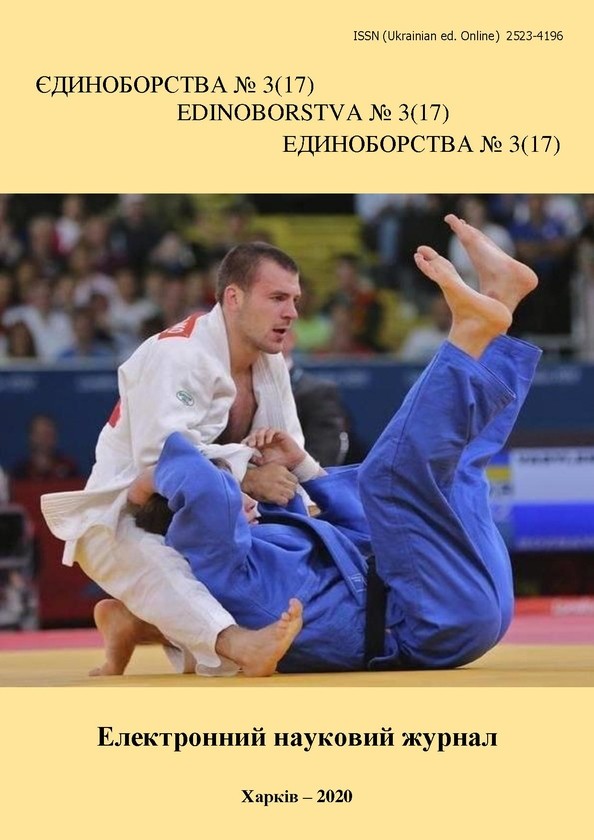Development of an algorithm for assessing the neurodynamic properties of kickboxing athletes
DOI:
https://doi.org/10.15391/ed.2020-3.04Keywords:
psychophysiological diagnostics, typological properties of higher nervous activity, acmeological campaignAbstract
Purpose: to develop an algorithm for assessing the neurodynamic properties of kickboxing athletes. Material and methods. The following methods were used in the study: analysis of scientific and methodological information and Internet sources; psychophysiological research methods; methods of mathematical statistics. Results: аn analysis of modern scientific work on the organization of the training process, its planning and increasing the effectiveness of competitive activity indicates that the individual typological properties of the higher nervous activity of kickboxer athletes are one of the basic indicators of the psychology of sports, which can directly affect the effectiveness of training loads and competitive activity. The article presents the materials and results of a study of indicators of the individual neurodynamic properties of kickboxer athletes of the ISKA Kickboxing Federation of Ukraine. Using the computer system of psychophysiological diagnostics “Diagnost-1”, the sensory component of the psychophysiological state of athletes included in the focus group was determined. To assess the psychophysiological state, a simple visual-motor reaction, the reaction of selecting one signal out of three, the reaction of selecting two signals out of three, with recording the latency period and the number of errors were determined. As a result of the research, data were obtained characterizing the individual typological properties of the higher nervous activity of the sensorimotor functions of athletes. Conclusions. Аn analysis of the results indicates that low psychophysiological indicators were demonstrated in the group of athletes examined. It was established that the number of mistakes made by athletes during the performance of psychophysiological testing increased depending on the complexity of the tests. The overall result of the studies makes it possible to assert that the psychophysiological state of the athletes who were part of the focus group corresponds to a low and below average level. The results of the study are appropriate for the development of methodological support for modeling the training activities of kickboxers at the stage of basic training and competitive activity, as well as for the implementation of sports selection and individualization of training activities of kickboxers.
References
Аксютін, В. В. & Коробейніков, Г. В. (2014). Психофізіологічний стан та спеціальна працездатність у боксерів із різними стилями ведення поєдинку. Педагогіка, психологія та медико-біологічні проблеми фізичного виховання і спорту, 12, 3-6.
Арзютов, Г. М. (2000). Теорія і методика поетапної підготовки спортсменів (на матеріалі дзюдо) (Автореф. дис. … канд. наук з фіз. вих. і спорту). Київ, Україна.
Єрмаков, С. С. (2002). Інформаційні технології в наукових спортивних дослідженнях, Наукові праці націольнальної бібліотеки України ім. В. І. Вернадського, 8, 272-280.
Ильин, Е. П. (1978). Теория функциональной системы и психо-физиологические состояния. Теория функциональных систем в физиологии и психологии, 325-346.
Камчатников, А. Г. (2011). Психофизиология спортивной деятельности: учебно-методическое пособие с мультимедийным сопровождением. ВГАФК, Волгоград.
Макаренко, М. В. & Лизогуб, В. С. (2006). Компьютерный комплекс для психофизиологического тестирования «НС-Психотест». Руководство по эксплуатации НСФТ 010999.001 РЭ. 41-60.
Коробейников, Г. В., Коробейникова Л. Г., Рычок, Т. М., & Мищенко, В.С. (2014). Психофизиологическая диагностика функциональных состояний у борцов. Актуальные вопросы развития физической культуры и массового спорта на современном этапе. Материалы Всероссийской научно-практической конференции с международным участием, посвященной 90-летию Н. Н. Тарского. Республика Саха, с. Намцы, Чурапчинский государственный институт физической культуры и спорта, 251-261.
Коробейніков, Г. В., Аксютін, В. В. & Смоляр, І. І. (2015). Зв’язок стилів ведення поєдинку боксерів із психо-фізіологічними характеристиками. Педагогіка, психологія та медико-біологічні проблеми фізичного виховання і спорту. 9, 33-37.
Коробейніков, Г. В., Бітко, С. М., Сакаль, Л. Д., & Кулініч, І. В. (2003). Психофізіологічне забезпечення діагностики функціонального стану висококваліфікованих спортсменів. Актуальні проблеми фізичної культури і спорту, 53-60.
Кузікова, С. Б. (2011). Психологія саморозвитку: навчальний посібник. Сум. держ. пед. ун-т ім. А. С. Макаренка, Суми.
Лоскутова, Т. Д. (1975). Оценка функционального состояния центральной нервной системы человека по параметрам простой двигательной реакции. Физиологический журнал, 1, 3-12.
Лукьяненко, В. П., & Воликов, Р.А. (2015). Индивидуализация тренировочного процесса на предсоревновательном этапе в кик-боксинге. Мир науки, культуры, образования, 2(51), 260-262.
Макаренко, М.В. (1999). Методика проведення обстежень та оцінки індивідуальних нейродинамічних властивостей вищої нервової діяльності людини. Фізіологічний журнал, 4, 125-131.
Макаренко, М. В., Лизогуб, В. С., & Безкопильний, О. П. (2004). Нейродинамічні властивості спортсменів різної кваліфікації та спеціалізації. Актуальні проблеми фізичної культури і спорту, 4, 105-110.
Макаренко, Н. В. (2005). Формирование свойств нейродинамических функций у спортсменов, Наука в олимпийском спорте, 2, 80-85.
Мельников, Д. С. & Селиверстова, В. В. (2010). Психофизиологическое тестирование спортсменов. Учебно-методическоепособие. СПб.
Міщенко, В. С., Коробейніков, Г. В., Коробейнікова, Л. Г., Зіневич, Я. В., & Вольський Д С. (2017). Психофізіологічний стан елітних спортсменів в динаміці тренувального макроциклу. Український журнал медицини, біології та спорту Миколаїв, 3(5), 201-208.
Сопов, В. Ф. (2013). Проблема формирования методологически обоснованного психодиагностического инструментария в психологическом обеспечении высококвалифицированных спортсменов. Вестник спортивной науки, 5, 40-43.
Скирта О. В., Горбенко В. М., Хацаюк О. А., & Пікінер О. М. (2014). Дослідження завадостійкості кікбоксерів у розділі орієнтал на етапі спеціалізованої базової підготовки. Спортивний вісник Придніпров’я, 3, 110-116.
Фрицюк, В. А. (2017). Методологічні підходи до вивчення проблеми професійного саморозвитку майбутнього фахівця. Вісник Вінницького політехнічного інституту, 6, 160-167.
Arent, S. M., & Landers, D. M. (2003). Arousal, anxiety, and performance: a reexamination of inverted-U Hypothesis. Research Quarterly for Exerzise and Sport, 4 (74), 436-444.
Iermakov, S., Podrigalo, L., Romanenko, V., Tropin, Y., Boychenko, N., Rovnaya, O. & Kamaev, O. (2016). Psycho-physiological features of sportsmen in impact and throwing martial arts. Journal of Physical Education and Sport. 16(2), 67, 433-441.
Podrigalo, L., Iermakov, S., Romanenko, V., Rovnaya, O., Tropin, Y., Goloha, V., & Halashko, O. (2019). Psychophysiological features of athletes practicing different styles of martial arts - the comparative analysis. International Journal of Applied Exercise Physiology, 8(1), 84-91.
Romanenko, V., Podrigalo, L., Iermakov, S., Rovnaya, O., Tolstoplet, E., Tropin, Y., & Goloha, V. (2018). Functional state of martial arts athletes during implementation process of controlled activity–comparative analysis. Physical Activity Review, 6, 87-93.













